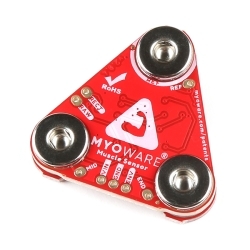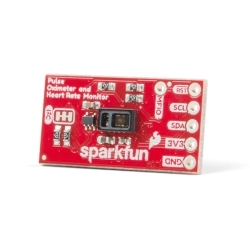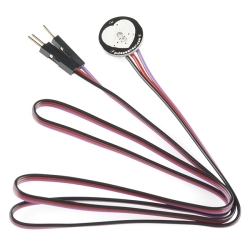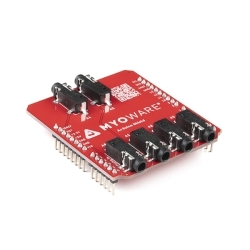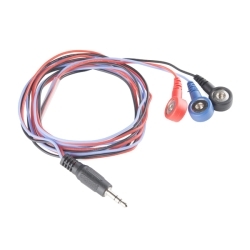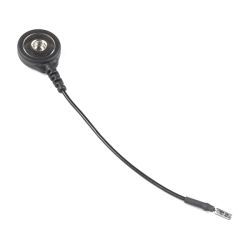MyoWare 2.0 Muscle Sensor Basic Kit
The MyoWare® 2.0 Muscle Sensor Basic Kit is an Arduino-compatible, EMG sensor kit that provides you with the essential boards from the MyoWare ecosystem.
Product Overview
The MyoWare® 2.0 Muscle Sensor Basic Kit, an Arduino-compatible, all-in-one electromyography (EMG) sensor kit that provides you with the bare minimum from the MyoWare 2.0 ecosystem to get started measuring and visualizing muscle activity. Simply snap on the MyoWare 2.0 LED Shield, add some EMG sensor pads, attach the sensor to a muscle group, and flex! The kit also includes a mini screwdriver to easily remove shields, USB A to C cable to recharge the 40mAh LiPo battery, and MyoWare 2.0 Reference Cable to connect to large muscle groups.
The MyoWare 2.0 Muscle Sensor included in this kit has been redesigned from the ground up with a new easy-to-use, compact design and upgraded with the latest and greatest chipset improving sensor performance and reliability. The sensor measures muscle activity through the electric potential of the muscle, commonly referred to as surface electromyography (EMG or sEMG for short). When your brain tells your muscle to flex, it sends an electrical signal to your muscle to start recruiting motor units (the bundles of muscle fibers that generate the force behind your muscles).
The harder you flex, the more motor units are recruited to generate greater muscle force. The greater the number of motor units, the more the electrical activity of your muscle increases. MyoWare 2.0 Muscle Sensor will analyze the filtered and rectified electrical activity of a muscle and output a signal (0-VIN volts, where VIN signifies the voltage of the power source) that represents how hard the muscle is being flexed. The innovative snap connector system eliminates the need to solder connections with the MyoWare 2.0 LED Shield. The blue 10-segment bar graph provides a visual representation of the measured signal. The more muscle activation measured, the higher up the board LEDs will go!
This kit is constructed to follow the standalone example featured in the MyoWare 2.0 Muscle Sensor Guide without the need for a microcontroller. Use it to gauge how hard you’re working a muscle during a workout, as a teaching tool, or add some myoelectric flair to your Halloween costume!
Not sure which set of boards to use from the MyoWare 2.0 ecosystem for your application? Check out the MyoWare 2.0 Muscle Sensor Development Kit. The development kit includes all the boards from the MyoWare 2.0 ecosystem and accessories to test out different configurations for your application.
Note: This item may take longer to process due to the battery installed in the equipment and therefore does not qualify for same-day shipping policy. Additionally, these batteries can not be shipped via Ground or Economy methods to Alaska or Hawaii. Sorry for any inconvenience this may cause.
The MyoWare 2.0 Muscle Sensor and LED Shield are not intended for use in the diagnosis of disease or other conditions, or in the cure, mitigation treatment, or prevention of disease, in a man or other animals.
The MyoWare 2.0 ecosystem consists of shields that easily interface with the MyoWare® 2.0 Muscle Sensor, which is a low-cost, Arduino-compatible, all-in-one electromyography (EMG) sensor from Advancer Technologies. The innovative connector system allows users to easily snap shields together with a compact low profile and connect to a microcontroller's analog input to measure raw, filtered, and rectified electrical activity of a target muscle. This eliminates the need to solder connections between boards.
This product is a collaboration with Brian Kaminski from Advancer Technologies. A portion of each sales goes back to them for product support and continued development.
Features & Specs
MyoWare 2.0 Muscle Sensor Features:
- Wearable Design
- Supply Voltage
- Minimum: +2.27V
- Typically: +3.3V to +5V
- Maximum: +5.47V
- Input Bias Current
- 250pA, max 1nA
- Reverse Polarity Protection
- Three Output Modes
- Raw EMG
- Rectified
- Envelope
- Expandable via Shields
- MyoWare® 2.0 Muscle Sensor Form Factor
- 3x Female Snap Pins (Power and EMG Envelope Output)
- 3x Male Snap Pins (Input Electrodes)
- LED Indicators
- VIN
- ENV
- Reference Electrode Jumper
- Specially Designed For Microcontrollers
- Adjustable Gain
- Board Dimensions
- 37.57mm x 35.90mm (1.48” x 1.41”)
- PCB board thickness increased.
- NPTH for snap connector buttons.
- Updated footprint for snap connectors buttons with slots for improved cleaning.
- Updated size of reference pin's jumper pad.
Documentation
- Board Dimensions
- MyoWare 2.0 Muscle Sensor
- MyoWare 2.0 LED Shield
- Hookup Guide
- Advancer Technologies: MyoWare® 2.0
- Quickstart Guide (4.37MB)
- Advanced Guide (9.00MB)
- Patents [1]
- MCP73831 Datasheet
- Polymer Lithium Ion Battery (40mAh)
- Datasheet
- MSDS
- Arduino Reference Language: ArduinoBLE Library
- GitHub Example Repo
- MyoWare 2.0 Ecosystem Page
[1] Note: This product is patent protected. To prevent counterfeit boards
Customer Reviews

Stock and Customer Discounts
Available Discounts
- $73.63 | 10+ units
- $69.75 | 25+ units
- $65.88 | 100+ units





